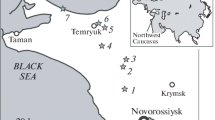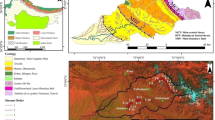Abstract
Comparison of trace element distribution in bulk samples from the North-Western Caucasus mud volcanoes with PAAS (average Australian post-Archean shale) showed their depletion in many elements. The contents of most elements in sediments of the mud volcanoes are comparable with those of the Middle Maikopian clay. Compared to the Upper Maikopian clay, most of the studied samples have much higher concentrations of Mo, Sr, Y, Nb and Ba, whereas contents of many other elements, in contrast, are lower. The rare earth elements (REE) distribution in bulk sediment samples is similar to that of PAAS. On the La/Sc–Th/Co diagram, the compositions of most bulk samples of the North-Western Caucasus mud volcanoes fall in the field typical of disintegration products of felsic rocks. This is confirmed by their localization in the Cr/Th–Th/Sc and Sc–Th/Sc diagrams. The comparison of the distribution of data points of sediments of mud volcanoes of the North-Western Caucasus, the Junggar Basin, and the Andaman Islands on the La/Sc–Th/Co and Cr/Th–Th/Sc diagrams shows that the latter have a large contribution of geochemically immature components, possibly the disintegration products of mafic igneous rocks. The data points of sediments ejected from the North-Western Caucasus mud volcanoes on the La/Sc–Th/Co and Cr/Th–Th/Sc diagrams show the wider compositional range than those of other two regions (mixing “felsic” and “mafic” components in the proportions ~100 : 1 to 50 : 50). In general, the comparison of trace element distribution in sediments from mud volcanoes of the North-Western Caucasus, the Junggar Basin and the Andaman Islands suggests the geochemical heterogeneity of these sediments not only in different geodynamic regions, but also within mentioned mud volcanic provinces, thus indicating a heterogeneous composition of their sources.













Similar content being viewed by others
Notes
These rocks are determined in (Melchakov et al., 2017, p 338) as “clays beyond the fault zone”, but more detailed information is absent.
Calculated using formula (Hosample/HoPAAS)/√(Dysample/ DyPAAS) × (Ersample/ErPAAS).
In particular, Aliev (2006) indicated that the solid phase (volcanic breccia) of mud volcanic products of the South Caspian petroleum basin is specialized for boron, mercury, manganese, barium, strontium, lithium, rubidium, and cesium, whose contents are many times higher than the average/clarke contents for sedimentary rocks.
According to concepts (Idris, 2008, and others), the enrichment factor, EF, <1, implies that the enrichment of sediments/mud volcanic products in trace elements is absent. The EF values from 1 to 3 suggest an insignificant enrichment, while EF from 3 to 5 means a moderate enrichment.
(Ce/Ce*)PAAS was calculated using formula 0.5(Lasample/LaPAAS) + 0.5(Prsample/PrPAAS).
It is however impossible to establish exactly which complexes were sources of this “mafic” component. It is known that the Late Mesozoic–Cenozoic deposits of the Greater Caucasus are devoid of mafic volcanic rocks. Mafic volcanism and its erosion products in this area were more typical of the Early Jurassic, but available data are insufficient to determine whether they were involved in mud volcanism.
REFERENCES
A. D. Aliev, “Mud volcanism of the South Caspian petroleum basin,” Geol. Polzen. Iskop. Mirovogo Okeana, No. 3, 35–51 (2006).
A. S. Astakhov, K. F. Sergeev, O. A. Mel’nikov, A. V. Prisyazhnyuk, R. B. Shakirov, P. F. Brovko, and V. I. Kiselev, “Dynamics of defluidization of the deep–seated central Sakhalin Fault during seismic activation: results of monitoring of the Southern Sakhalin Mud Volcano in July–August 2001,” Dokl. Earth Sci. 386 (7), 742–747 (2002).
M. Bau, K. Schmidt, A. Koschinsky, J. Hein, T. Kuhn, and A. Usui, “Discriminating between different genetic types of marine ferro–manganese crusts and nodules based on rare earth elements and yttrium,” Chem. Geol. 381, 1–9 (2014).
M. R. Bhatia, “Plate tectonics and geochemical composition of sandstones,” J. Geol. 91, 611–627 (1983).
M. R. Bhatia and K. A. W. Crook, “Trace element characteristics of graywackes and tectonic setting discrimination of sedimentary basins,” Contrib. Mineral. Petrol. 921, 181–193 (1986).
L. Braccialli, M. Marroni, L. Pandolfi, and S. Rocchi, “Geochemistry and petrography of Western Tethys Cretaceous sedimentary covers (Corsica and Northern Apennines): from source areas to configuration of margins,” Sedimentary Provenance and Petrogenesis: Perspectives from Petrography and Geochemistry, Ed. by J. Arribas, S. Critelli, and M. J. Johnsson, Geol. Soc. Am. Spec. Pap. 420, 73–93 (2007).
K. C. Condie, “Chemical composition and evolution of the upper continental crust: contrasting results from surface samples and shales,” Chem. Geol. 104(1–4), 1–37 (1993).
K. C. Condie and D. A. Wronkiewicz, “The Cr/Th ratio in Precambrian pelites from the Kaapvaal Craton as an index of craton evolution,” Earth Planet. Sci. Lett. 97 (3–4), 256–267 (1990).
R. L. Cullers, “Implications of elemental concentrations for provenance, redox conditions, and metamorphic studies of shales and limestones near Pueblo, CO, USA,” Chem. Geol. 191 (4), 305–327 (2002).
V. Dekov, Hydrothermal Sedimentation in the Pacific Ocean (Nauka, Moscow, 1994) [in Russian].
V. V. Ershov and Yu. A. Perstneva, Lithochemical characteristics of the mud volcanic breccias worldwide,” Otechestvennaya Geol., No. 4, 72–83 (2018).
C. M. Fedo, G. M. Young, and H. W. Nesbitt, “Paleoclimatic control on the composition of the Paleoproterozoic Serpent Formation, Huronian Supergroup, Canada: a greenhouse to icehouse transition,” Prec. Res. 86, 201–223 (1997).
Yu. A. Fedorov, “Monitoring, control and prediction of activity of submarine mud volcanoes,” Natural and Social Risks in the Coastal Zone of the Black and Azov Seas (Triumf, Moscow, 2012), pp. 22–32 [in Russian].
Yu. A. Fedorov, “Isotope composition as an indicator of setting of generation of aqueous and hydrocarbon fluids of mud volcanoes of the Taman Peninsula,” Geological Evolution of Water–Rock Interaction (BNTs SO RAN, Ulan-Ude, 2018), pp. 319–323.
Yu. N. Fedorov, A. V. Maslov, and Yu. L. Ronkin, “Trace-element systematic of the eruption products of some mud volcanoes of the Kerch–Taman area: ICP–MS data,” Litosfera, No. 5, 117–123 (2011).
A. V. Gorbatikov, A. L. Sobisevich, and A. N. Ovsyuchenko, “Development of the Model of the Deep Structure of Akhtyr Flexure-Fracture Zone and Shugo Mud Volcano,” Dokl. Earth Sci. 421A (6), 969–973 (2008).
N. A. Grigor’ev, “Clarke content of chemical elements in the upper continental crust,” Litosfera, No. 1, 61–71 (2002).
M. M. Herron, “Geochemical classification of terrigenous sands and shales from core or log data,” J. Sed. Petrol. 58, 820–829 (1988).
A. M. Idris, “Combining multivariate analysis and geochemical approaches for assessing heavy metal level in sediments from Sudanese harbors along the Red Sea coast,” Microchem. J. 90 (2), 159–163 (2008).
M. A. Karasik and V. I. Morozov, “Mercury distribution in the mud volcanic products of the Kerch–Taman province,” Geokhimiya, No. 6, 668–677 (1966).
I. A. Khod’kova, and S. D. Gamp, “Distribution of lithium, rubidium, and cesium in solid emissions of mud volcanoes of the Kerch–Taman area,” Geokhimiya, No. 12, 1495–1503 (1970).
V. N. Kholodov, “Mud volcanoes, their distribution regularities and genesis: communication 1. Mud volcanic provinces and morphology of mud volcanoes,” Lithol. Miner. Resour. 37 (3), 197–209 (2002).
V. N. Kholodov, “Mud volcanoes: distribution and genesis,” Geol. Polezn. Iskop. Mirovogo Okeana, No. 4, 5–27 (2012).
E. V. Kudryashev, “Geological essay on Shugo mud volcano (Kuban),” Results of Study of Mud Volcanoes of the Crimean–Caucasian Geological Province (AN SSSR, Moscow, 1939) pp. 45–56 [in Russian].
V. Yu. Lavrushin, Underground Fluids of the Great Caucasus and its Surrounding (GEOS, Moscow, 2012) [in Russian].
V. Lykousis, S. Alexandri, J. Woodside, G. De Lange, A. Dahlmann, C. Perissoratis, K. Heeschen, Chr. Ioakim, D. Sakellariou, P. Nomikou, G. Rousakis, D. Cases, and G. Ercilla, “Mud volcanoes and gas hydrates in the Anaximander Mountains (Eastern Mediterranean Sea),” Mar. Petrol. Geol. 26 (6), 854–872 (2009).
A. V. Maslov, M. T. Krupenin, and D. V. Kiseleva, “Lithogeochemistry of the fine-grained siliciclastic rocks of the Vendian Serebryanka Group of the Central Urals,” Geochem. Int. 49 (10), 974–1001 (2011).
Yu. L. Melchakova, A. E. Kozarenko, and V. T. Surikov, “Geochemical effect of mud volcanism of the Bulganak mud volcanic field, Crimea,” Modern Problems of the State and Evolution of Biosphere Taxa (GEOKHI RAS, Moscow, 2017), pp. 355–360.
N. A. Mhammedi, B. El Moumni, A. El Hmaidi, A. Raissouni, and A. El Arrim, “Mineralogical and geochemical study of mud volcanoes in north Moroccan Atlantic margin,” Afr. J. Environ. Sci. Technol. 2 (11), 387–396 (2008).
O. L. Morozov, “Geochemistry and lithology of accretionary wedge in the Pekul’nei Range, Central Chukotka,” Lithol. Mineral. Resour. 35 (2), 163–182 (2000).
R. Nakada, Y. Takahashi, U. Tsunogai, G. Zheng, H. Shimizu, and K. H. Hattor, “A geochemical study on mud volcanoes in the Junggar Basin, China,” Appl. Geochem. 26, 1065–1076 (2011).
R. R. Rakhmanov, Mud Volcanoes and their Significance in the Prediction of Petroleum Potential of Interiors (Nedra, Moscow, 1987) [in Russian].
B. D. Roser and R. J. Korsch, “Determination of tectonic setting of sandstone–mudstone suites using SiO2 content and K2O/Na2O ratio,” J. Geol. 94, 635–650 (1986).
R. B. Shakirov, A. V. Sorochinskaja, N. S. Syrbu, I. B. Tsoy, H. Nguyen, and D. A. Le, “Geochemical features of Sakhalin Island mud volcanoes,” Vietnam J. Earth Sci. 40 (1), 56–69 (2018).
E. F. Shnyukov, Yu. V. Sobolevskii, G. I. Gnatenko, V. A. Kutnii, and P. I. Naumenko, Mud Volcano of the Kerch–Taman Area (Atlas) (Naukova Dumka, Kiev, 1986) [in Russian].
E. F. Shnyukov, G. I. Gnatenko, V. A. Nesterovskii, and O. V. Gnatenko, Mud Volcanism of the Kerch–Taman Area (Naukova Dumka, Kiev, 1992) [in Russian].
E. V. Sklyarov, Interpretation of Geochemical Data (Intermet Inzhiniring, Moscow, 2001) [in Russian].
A. L. Sobisevich, A. V. Gorbatikov, and A. N. Ovsyuchenko, Deep structure of the Mt. Karabetov mud volcano,” Dokl. Earth Sci. 422 (7), 1181–1185 (2008).
E. Sokol, S. Kokh, O. Kozmenko, S. Novikova, P. Khvorov, E. Nigmatulina, E. Belogub, and M. Kirillov, “Mineralogy and geochemistry of mud volcanic ejecta: A new look at old issues (a case study from the Bulganak Field, Northern Black Sea),” Minerals 8, 344 (2018). https://doi.org/10.3390/min8080344
A. V. Sorochinskaya, R. B. Shakirov, A. I. Obzhirov, N. V. Zarubina, and A. A. Karabtsov, “Geochemical and mineralogical features of mud volcanoes of Sakhalin Peninsula,” Vestn. Dal’nevost. Otd. Ross. Akad. Nauk, No. 4, 58–65(2008).
E. Talas, M. Duman, F. Kucuksezgin, M. L. Brennan, and N. A. Raineault, “Sedimentology and geochemistry of mud volcanoes in the Anaximander mountain region from the Eastern Mediterranean,”Sea. Marine Pollut. Bull.95, 63–71 (2015).
S. R. Taylor and S. M. McLennan, The Continental Crust Its Composition and Evolution (Blackwell, Oxford, 1985).
J. H. Ten Veen, J. M. Woodside, T. A. Zitter, J. F. Dumont, J. Mascle, and A. Volkonskaia, “Neotectonic evolution of the Anaximander Mountains at the junction of the Hellenic and Cyprus arcs,” Tectonophysics 391 (1), 35–65 (2004).
T. Yu. Tveritinova, A. L. Sobisevich, L. E. Sobisevich, and D. V. Likhodeev, “Structural position, structure, and formation of Mt. Karabetov mud volcano,” Geol. Polezn. Iskop. Mirovogo Okeana, No. 2, 106–122 (2015).
A. Vignesh, N. Ramanujam, Q. Rasool, and K. B. Swapan, “Geochemical evidence for provenance, tectonic settings and presence of gas hydrate in mud volcano sediments of Andaman Islands,” Oil Gas Res. 2, 111 (2016). https://doi.org/10.4172/ogr.1000111
A. P. Vinogradov, “Average content of chemical elements in the major types o igneous rocks,” Geokhimiya, No. 7, 555–571.
Z. Wan, Q. Shi, Y. Yuan, X. Shi, and B. Xia, “Sedimentary and geochemical signatures of mud volcanoes in the southern margin of the Junggar Basin, Northwestern China,” J. Earth Sci. 27 (2), (2015). http://en.earth–science.nethttps://doi.org/10.1007/s12583-000-0000-0
ACKNOWLEDGMENTS
We are grateful to G.I. Komarov, A.G. Kurilko, V.I. Rusanov, and A.V. Shevchenko for help in sampling. N.S. Glushkova is thanked for help in preparing the graphical works. Comments of reviewers significantly improved the manuscript.
Funding
The results were interpreted in the framework of State Task of the Shirshov Institute of Oceanology (project no. 0149-2019-0007).
Author information
Authors and Affiliations
Corresponding authors
Additional information
Translated by M. Bogina
Rights and permissions
About this article
Cite this article
Maslov, A.V., Shevchenko, V.P. Systematics of Trace Elements in Sediments from the North-Western Caucasus Mud Volcanoes. Geochem. Int. 58, 1027–1049 (2020). https://doi.org/10.1134/S001670292008008X
Received:
Revised:
Accepted:
Published:
Issue Date:
DOI: https://doi.org/10.1134/S001670292008008X




